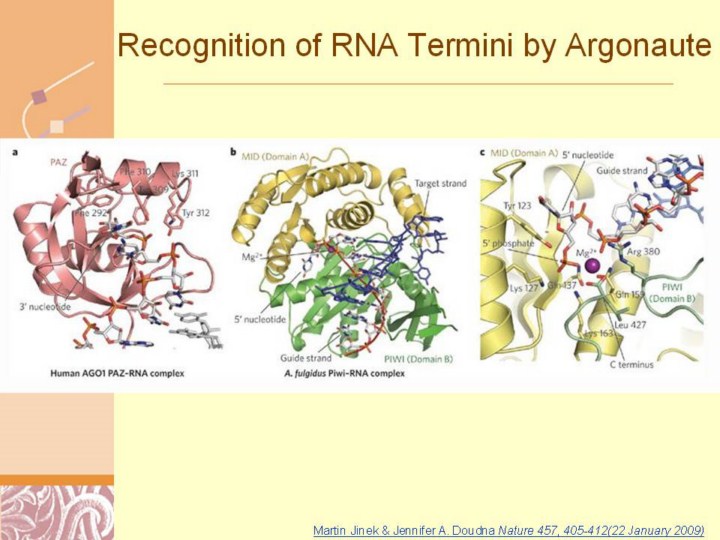| front |1 |2 |3 |4 |5 |6 |7 |8 |9 |10 |11 |12 |13 |14 |15 |16 |17 |18 |19 |20 |21 |22 |23 |24 |25 |26 |27 |28 |29 |30 |31 |32 |33 |34 |35 |36 |37 |38 |39 |40 |41 |42 |43 |44 |45 |review |
 |
Martin Jinek & Jennifer A. Doudna Nature 457, 405-412(22 January 2009)
a, The crystal structure of the PAZ domain of human AGO1 (ribbon format) is shown in complex with an siRNA-like duplex (stick format) (PDB identity 1SI3). Conserved residues in contact with the 3' nucleotide are shown in stick format and labelled. The 3' end of the siRNA inserts into a preformed hydrophobic pocket, with the base of the 3' nucleotide stacking against an invariant aromatic residue (the phenylalanine at position 292 in the protein, Phe 292). b, The crystal structure of Archaeoglobus fulgidus Piwi bound to an RNA duplex (PDB identity 2BGG), which mimics the guide–target interaction, is shown. A. fulgidus Piwi is composed of a MID domain and a PIWI domain (also referred to as domain A and domain B, respectively). The 5' nucleotide of the guide strand (backbone shown in red) binds at the MID–PIWI domain interface and does not base-pair with the target strand (blue). c, Shown is a detailed view of the pocket in A. fulgidus Piwi that binds to the 5' end of small RNAs. A magnesium ion, coordinated by the C terminus of the protein (Leu 427) and the 5' phosphate group, is shown as a purple sphere. Conserved residues that are involved in metal-ion coordination and 5'-phosphate binding are shown in stick format and labelled. |